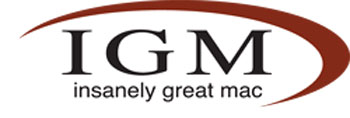November 20th 2002
Users looking to free themselves from the desktop have something new to look at with Apple's new PowerBook G4 lineup. Apple's laptops have reached a milestone, sporting up to 1 GHz speeds and DVD-R SuperDrives. As CPU speeds increase, one obstacle remains, and that is hard drive speeds. Laptop hard drives are smaller, lighter and more power efficient than their desktop counterparts. These features make for ideal laptop storage, but at a cost of speed. While a laptop CPUs may cruise at 1 GHz, it's still difficult to place a laptop on par with a desktop when hard drive data speeds can be anywhere from 1/2 to 1/4 slower.
Laptop drives measure 2.5-inches and spin at either 4200 or 5400 RPMs. Desktop drives measure 3.5-inches and speeds at 5400 or 7200 RPMs. Faster the rotation speed, often faster the data access. Apple's laptops typically run 4200 RPMs, and up until recently the company has offered a build-to-order option for a 5400 RPM drive. Recently, however, Apple has removed a 5400 RPM drive from it's lineup, much to the displeasure of some road warriors. While the 4200 RPM-only configuration has irked some PowerBook users, Apple may have had its reasons.
In most circles, the IBM Travelstar GNX 40 is considered to be the top dog for laptop hard drives. The drive spins at 5400 RPM, but most importantly it included an 8 MB cache. The new TiBooks include a 60 GB Fujitsu 2 MB cache drive (MHS2060AT), a change from 60 GB IBM drives that were shipping with earlier models. Curious as to see why Apple switched drives, and also to see what drive offers the best performance, we ran some hard drive tests and was surprised to see the Fujitsu score so well.
[PowerBook G4/1 GHz/1 GB RAM/Mac OS X 10.2.2. Each drive was reformatted into a single volume and had a fresh install of 10.2.1, then updated to 10.2.2. Tests were run with Apple's DiskBasher 1.1.2 (CHUD) and XBench 1.0b2 from Spiny Software.]
| DiskBasher MB/sec - IBM Travelstar GNX 40 (40 GB) |
| Size | Ave Rand Read | Ave Seq Read | Ave Rand Write | Ave Seq Write |
| 1 MB | 177.49 | 175.88 | 131.90 | 130.58 |
| 2 MB | 168.33 | 165.11 | 123.80 | 125.80 |
| 4 MB | 164.17 | 163.72 | 123.34 | 123.88 |
| 8 MB | 163.45 | 161.62 | 47.32 | 43.09 |
| 16 MB | 163.94 | 163.13 | 24.74 | 24.64 |
| DiskBasher MB/sec - Fujitsu MHS2060AT (60 GB) |
| Size | Ave Rand Read | Ave Seq Read | Ave Rand Write | Ave Seq Write |
| 1 MB | 182.20 | 178.27 | 132.12 | 132.12 |
| 2 MB | 169.40 | 168.46 | 126.12 | 125.93 |
| 4 MB | 167.48 | 166.42 | 124.30 | 125.09 |
| 8 MB | 166.26 | 166.25 | 32.16 | 31.92 |
| 16 MB | 165.74 | 166.53 | 25.98 | 25.89 |
| XBench MB/sec - IBM Travelstar GNX 40 (40 GB) |
| Seq Write | Seq Read | Rand Write | Rand Read |
| 24.20 | 24.08 | 14.76 | 12.98 |
| XBench MB/sec - Fujitsu MHS2060AT (60 GB) |
| Seq Write | Seq Read | Rand Write | Rand Read |
| 21.94 | 22.41 | 11.92 | 11.81 |
As you can see, the results were pretty surprising. The only explanation I can think of is the Fujitsu is just a well-built drive with higher data density that offsets the cache and rotation advantages of the IBM. The other alternative of course is that these bench marks aren't really reflecting real world use where the IBM's cache could come into play. The XBench marks do give the IBM drive an edge, but only around 10-percent. Granted, 10-percent is 10-percent, but swapping out the Fujitsu drive could be a tough sell.
Beyond performance, there are a couple other things to consider about the Fujitsu drive. At the top of the list is obviously a larger capacity of 60 GB vs 40, but the drive also uses less power, which translates into longer battery life. The IBM drive is very efficient, but it still is spins at 5400 RPMs, which does translate to a greater power drain even if marginally so. The Fujitsu is also, at least I think, noticeably quieter both spinning and operating. So if you want the maximum performance, the IBM drive may be the choice, but it's questionable to me whether it's worth the sacrifice of storage, battery and noise.
As closing comments, it's worth noting that IBM recently announced a new 7200 RPM 2.5-inch drive. When this drive ships, this could help push laptop drive performance higher, until then Mac users may be content using the stock Fujitsu drive in their new TiBooks.
Feel free to add your own opinions and insight in the comments below.
